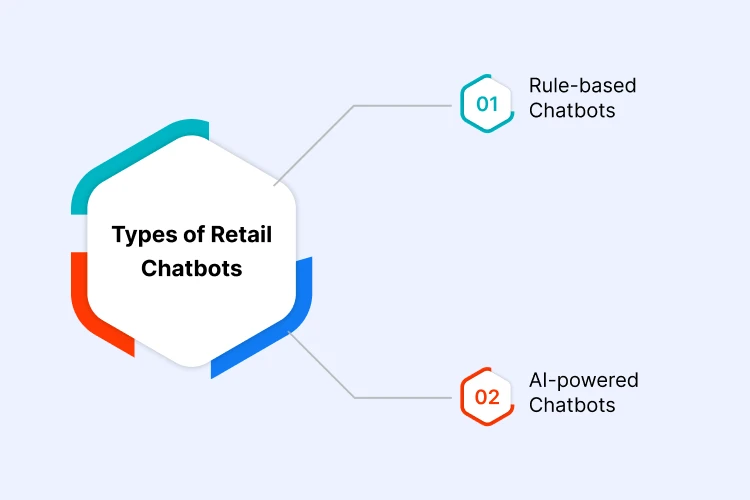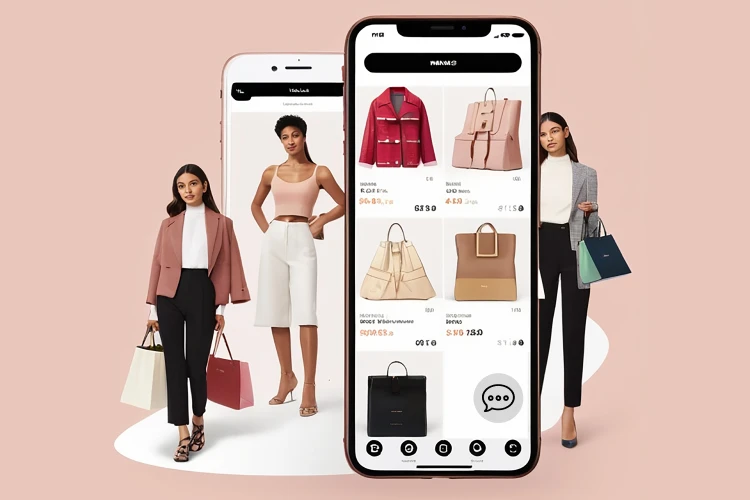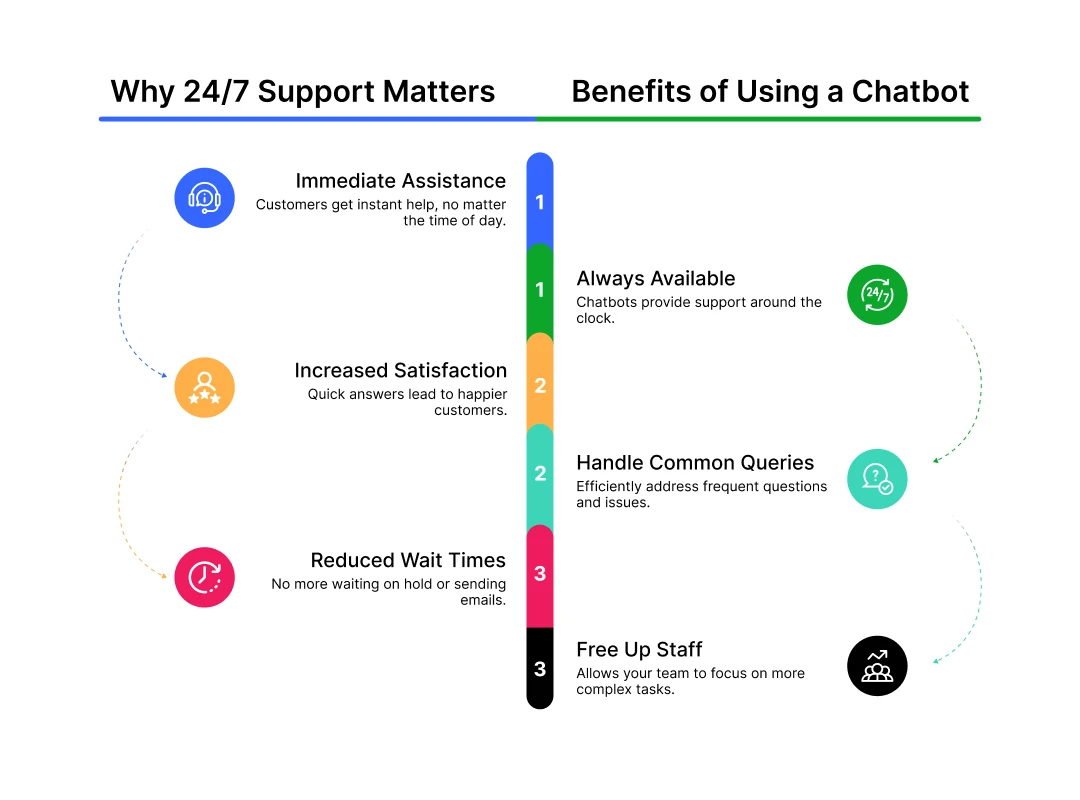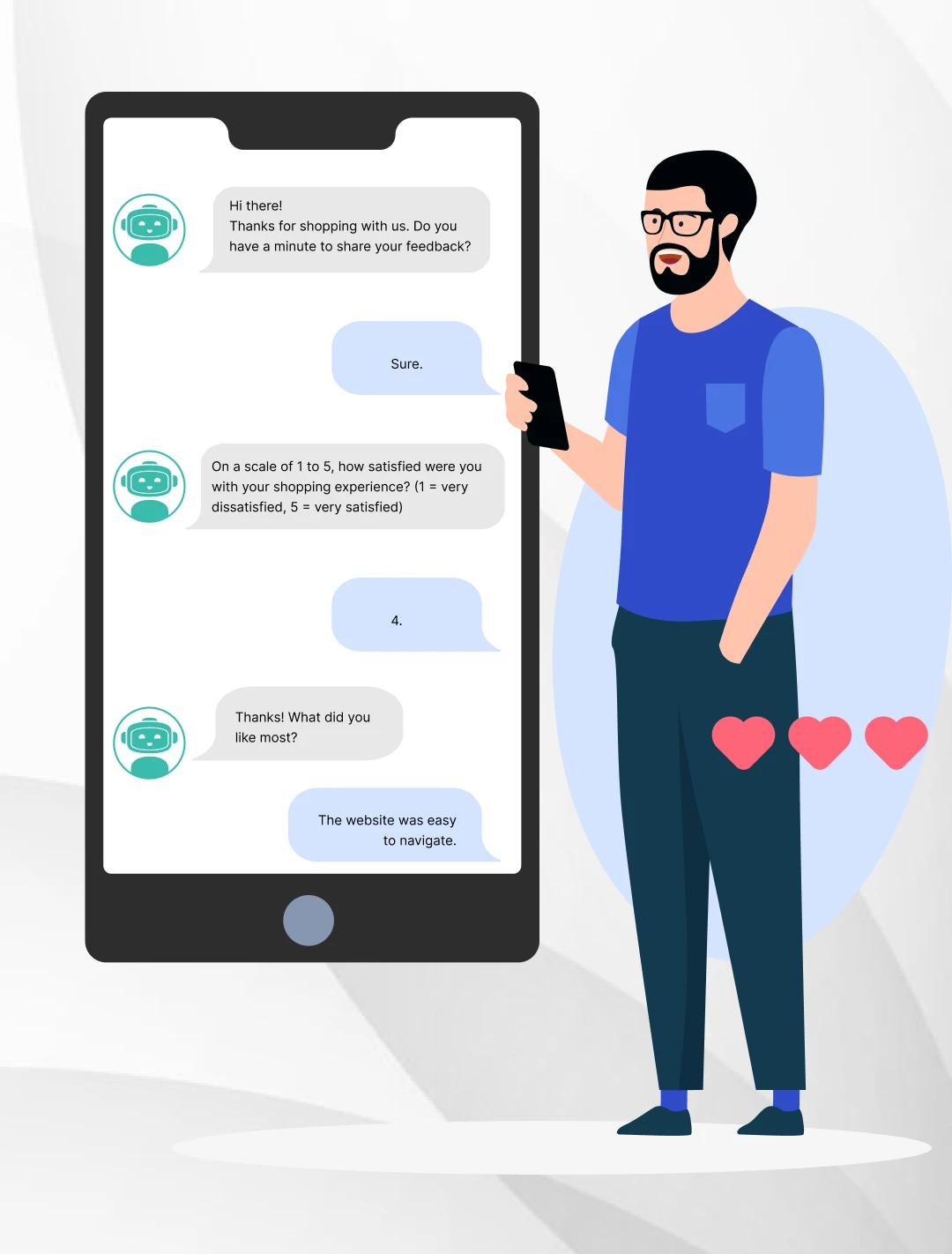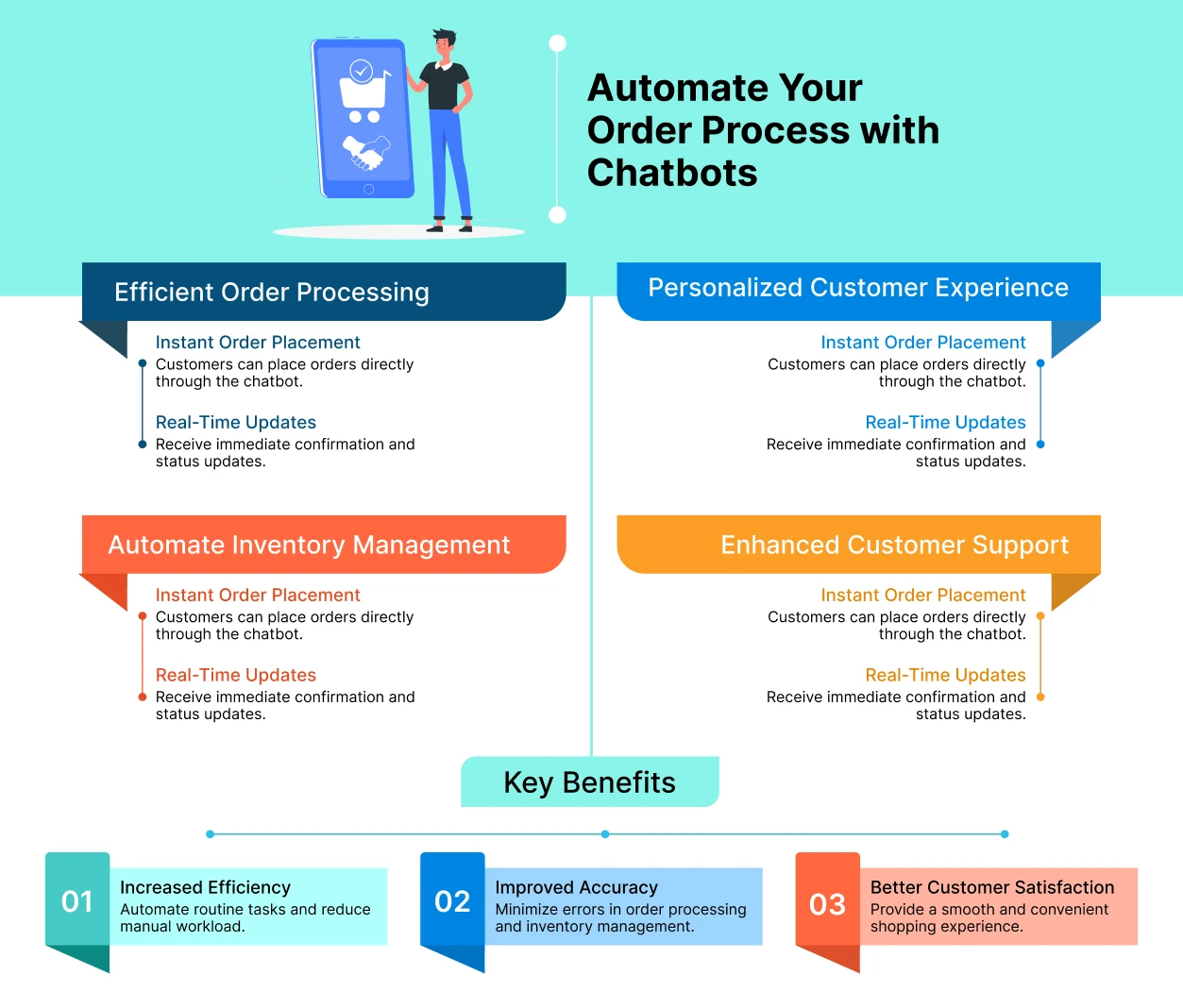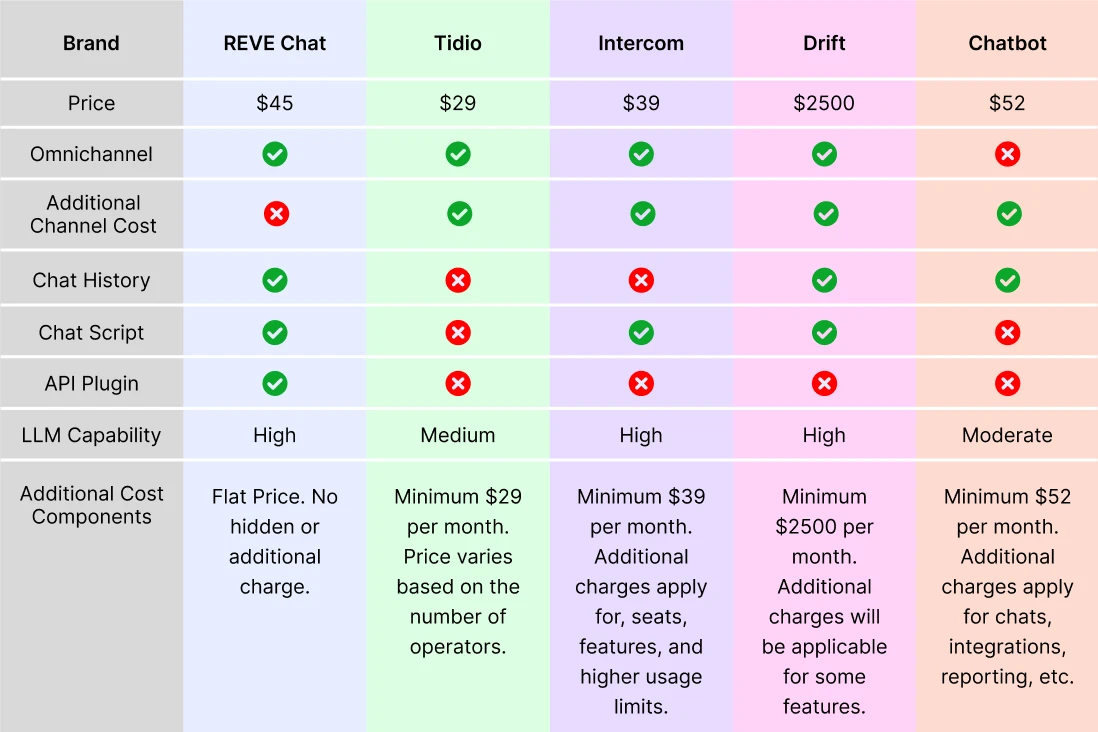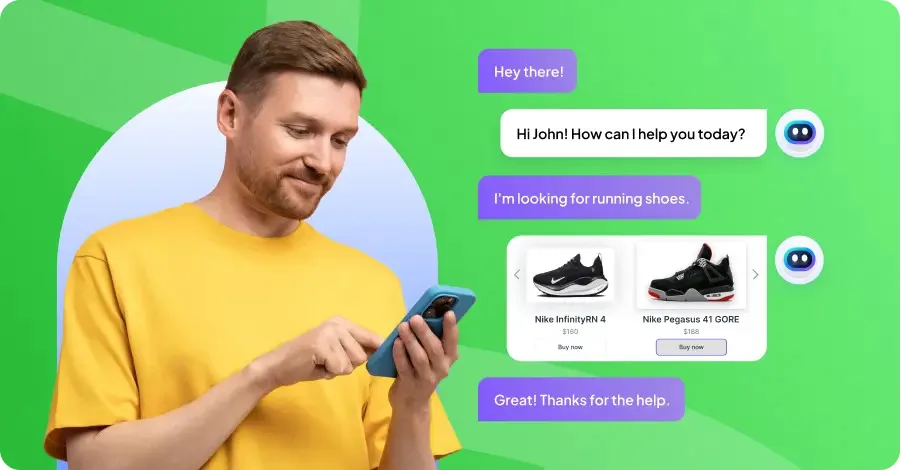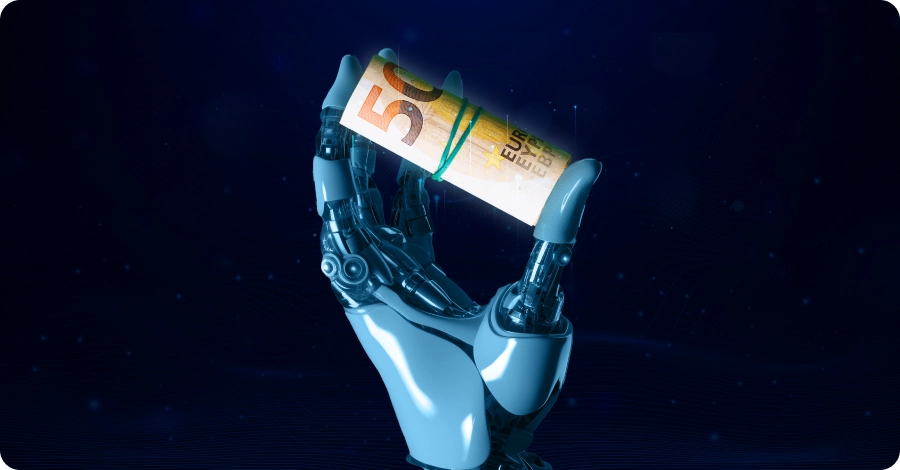Retail Chatbot Use Cases, Benefits & Examples
- July 31, 2024
- 22 mins read
- Listen
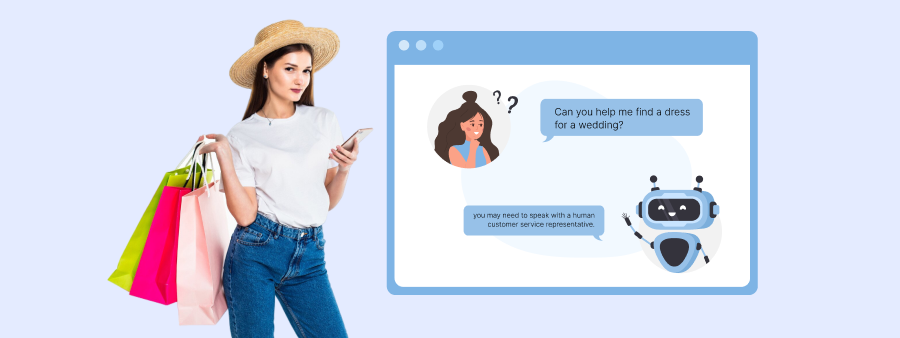
Table of Content
Online shopping is becoming more popular than ever. Retailers are constantly looking for new ways to engage with customers and provide a personalized shopping experience. But, what do you think can a retail chatbot be groundbreaking for business? How it will impact the overall business setting? Is it really useful for entrepreneurs?
Retail AI chatbots are changing the way retailers interact with their customers. With its ability to provide instant assistance, recommend products, and answer questions. This chatbot is quickly becoming a must-have for any successful online store. Are you wondering, how?
In this blog, we’ll explore all things related to shopping chatbots, their benefits, examples, and more. So, if you’re a retailer, don’t skip reading. You’ll learn a lot to boost your business by adapting to the latest technology.
What is a Retail Chatbot?
A retail chatbot is a tool used by retailers to engage with customers conversationally through messaging platforms. It uses AI to help shoppers with quick support when they need it. They answer questions and suggest products. They also keep tabs on orders and handle returns. Chatbots make shopping smoother and more fun. This boosts sales and keeps customers happy. The result? A better shopping experience all around.
Types of Retail Chatbots
For retail business, it is important to identify the right type of Chabot to deliver the best customer service experience for its customers. But, how many types of chatbots are there for retailers? Let’s explore so that you can find the ideal type for your business.
1. Rule-based Chatbots
These are the types of chatbots that resonate with pre-defined rules and patterns to respond to the user’s query. They are primarily limited in their capacity to understand natural language and contextual understanding.
A rule-based chatbot can be developed to answer questions that are frequently asked about hours, return policies, and some basics of products. For instance, a rule-based chatbot developed on a clothing retailer’s website in such a manner that it would respond with a fixed set of responses to help users find the right size or share information for shipping.
2. AI-powered Chatbots
These are the most advanced virtual assistants using AI, ML, and NLP technology to communicate with users. One of the best things about the AI chatbot is that it can understand human language, learn from interactions, and provide personalized responses. If you are still trying to figure it out let me give an example.
A retail AI chatbot helps customers find products, answer complex questions about features or availability, and even suggest items based on past purchases or preferences. This types of chatbot continuously improve their responses based on the data they gather. It uses data to enhance its interaction capability from time to time.
Why Does a Retail Store Need a Chatbot?
Retail business often serves a massive number of users. It is quite tough for a business to offer high-quality customer service for all. But, with a chatbot, it can make the process smoother and provide service faster. There are many reasons a retail business needs a chatbot. But, what are they? Let’s explore.
1. Improve Customer Service Efficiency With 24/7 Support
Having a chatbot on your retail store website allows customers to get immediate assistance at any time of the day or night. This can help improve customer satisfaction by providing quick answers to common questions and issues. Most importantly, it reduces the need for customers to wait on hold or send emails for support.
2. Increase Sales Through Personalized Recommendations
Retail AI chatbots can analyze customer behavior and preferences to provide personalized product recommendations. You can increase the likelihood of converting website visitors into paying customers. Based on previous purchases or browsing history.
3. Handle Multiple Customer Inquiries Simultaneously
Chatbots can manage multiple conversations simultaneously unlike human customer service representatives who can only handle one customer at a time. This means that even during peak times, all customers can receive prompt assistance without having to wait in long queues.
4. Reduce Operational Costs While Maintaining Quality Service
No doubt integrating a chatbot as part of your customer service strategy can help reduce operational costs associated with hiring and training additional staff members. Despite this cost reduction, retail Chabot helps to offer a quality service by providing accurate information and timely responses to customers.
5. Collect Valuable Data for Insights and Improvements
AI retail chatbots collect valuable data on customer interactions, preferences, and trends. You can gain insights into areas where improvements may be needed by analyzing this data. It helps to enhance the overall customer experience in your retail store.
6. Efficient Order Management
Do you want to make order management a breeze? Retail Chabot helps customers track orders, process returns, and handle refunds. This takes pressure off support teams and keeps customers happy. MetaPack’s survey shows that 96% of shoppers say good delivery makes them more likely to buy.
7. Multilingual Support
Sometimes global business faces a language barrier. But, with a chatbot, business breaks the language barrier easily. Chatbots can support multiple languages. It enables retailers to serve a global customer base effectively.
This enhances accessibility and customer satisfaction. Consumers prefer to interact in their native language. A survey by Common Sense Advisory found that 75% of consumers prefer to buy products in their native language.
Chatbot Use Cases In the Retail Industry
Retail businesses get tons of benefits from using Chabot to increase their customer satisfaction level, boost sales, and more. Now let’s take a look at chatbot use cases in retail.
1. Product Recommendations
Shopping chatbots analyze customer behavior, preferences, and purchase history to suggest relevant products. According to a report by Salesforce, 57% of customers are willing to share personal data in exchange for personalized offers or discounts. This capability enhances the shopping experience. So, recommend products to customers with the latest offers or any discount.
Plus, it increases the average order value and customer satisfaction. For example, Amazon’s recommendation algorithm which utilizes similar techniques, is responsible for 35% of the company’s total sales.
Tip:
- You can integrate proactive chat features to engage visitors with timely offers and assistance.
2. Locate Nearby Stores
Geolocation features help retail customers locate the nearest physical store. Retail chatbots provide directions, store hours, and even real-time inventory checks. According to a Google study, 30% of all mobile searches are related to location, indicating a significant demand for location-based services. As a result, retailers like Sephora use chatbots to guide customers to the nearest store.
Tips:
- Make sure your chatbot is available 24/7 to handle common customer inquiries and issues.
- Don’t forget to update your chatbot’s knowledge base regularly to keep up with new products and services.
3. Improve Marketing and Lead Generation
Do you know chatbots can engage customers in real-time conversations? It collects valuable data on their preferences and behaviors. This data can be used to create targeted marketing campaigns and generate qualified leads. A study by Drift found that businesses using chatbots for lead generation saw a 67% increase in sales.
For example, H&M’s chatbot engages customers by asking them about their fashion preferences and providing personalized style recommendations, which helps capture leads and increase sales.
4. Abandoned Carts
Now let’s talk about abandoned carts. It is a significant issue for online retailers, with an average cart abandonment rate of 69.57%. Do you know that AI-powered shopping chatbots can reduce this by sending automated reminders? Besides this offers incentives such as discounts or free shipping to encourage customers to complete their purchases.
For example, fashion retailer ASOS integrated a chatbot to address cart abandonment. Surprisingly, this integration helped the brand in a 25% reduction in abandoned carts.
Tips:
- Use chatbots to provide personalized discounts and promotions based on customer browsing history.
- You can integrate cart abandonment reminders to encourage customers to complete their purchases.
5. Order Tracking and Notifications
According to a study by MetaPack, 96% of consumers say a good delivery experience positively influences their purchase decisions. In this case, AI chatbots can give customers real-time updates on their order status, from processing to delivery. This reduces customer anxiety and enhances the post-purchase experience.
Retailers like Zara use chatbots to keep customers informed about their order status. As a result, the brand successfully brings higher customer satisfaction and loyalty.
Tips:
- You should configure your chatbot to assist with order tracking, returns, and refunds to improve the customer experience.
- Always deliver real-time updates and notifications about order status through the chatbot.
6. Educate Customers
Educating customers is crucial for retail businesses. But, sometimes it gets tougher for retailers because of their customer volume. With a retail chatbot, things become much easier.
- Chatbots can serve as virtual shopping assistants, providing detailed information about products, answering FAQs, and guiding customers through the buying process.
- This is particularly useful for complex or high-value products where customers need more information before making a purchase.
For example, the beauty retailer Sephora uses a chatbot to provide makeup tutorials and product recommendations. It helps customers make informed decisions. A report by Gartner predicts that by 2025, 80% of customer service interactions will be handled by AI, highlighting the growing importance of chatbots in customer education.
Tips:
- Provide detailed product information, tutorials, and how-to guides, helping customers make informed purchasing decisions.
- Use interactive FAQ sections within the chatbot to quickly address common customer questions and reduce support requests.
7. Support Live Agents
According to IBM, businesses can save up to 30% in customer support costs by integrating chatbots. This escalates issues to live agents when necessary. It ensures customers receive the help they need without delay.
Chatbots are ideal assistants to handle routine inquiries and basic tasks. As a result, it frees up live agents to focus on more complex issues.
Tip:
- Hand over routine queries and simple tasks on chatbots to free up live agents to focus on more complex and high-value interactions.
8. Send Personalized Notifications
Personalized notifications to customers about order updates, promotions, and recommendations are important for retailers. These messages have been shown to improve engagement rates significantly according to Epsilon.
These personalized emails deliver 6 times higher transaction rates. Retail chatbots tailor these notifications to individual preferences by using customer data. It enhances customer experience and drives sales.
9. Manage Loyalty Points
Retailers like Starbucks use chatbots to help customers track and redeem their loyalty points. This integration is helping the brand to increase engagement and retention.
Chatbots assist customers in managing their loyalty points by providing real-time updates on point balances, redemption options, and exclusive rewards. According to a study by Bond Brand Loyalty, 79% of consumers are more likely to join a loyalty program that offers personalized rewards.
10. Collect Customer Feedback
Retail business needs to collect customer data to enhance their service quality for customer satisfaction. Are you looking for ways to proactively gather customer feedback? You can use chatbots to conduct surveys and questionnaires. According to Microsoft, 77% of customers view brands more favorably if they proactively invite and accept customer feedback.
For example, eBay uses chatbots to collect feedback after each customer interaction. This approach allows them to continuously improve their service.
Tips:
- Don’t forget to use chatbot interactions to gather feedback and insights on customer preferences and pain points.
- You need to analyze chatbot data regularly to identify trends and areas for improvement in your services.
11. Improve Customer Support
With a shopping chatbot, you can skyrocket your customer support level. This type of chatbot is ideal for providing 24/7 customer support, addressing inquiries, and resolving issues outside of regular business hours. As a result, customers receive timely assistance, improving overall satisfaction. A report by Gartner predicts that by 2025, 85% of customer interactions will be managed without human involvement.
12. Multilingual Support
Chatbot breaks the language barrier for business. This capability is crucial for businesses looking to expand their reach and cater to diverse markets. According to a survey by Common Sense Advisory, 75% of consumers prefer to buy products in their native language. Retailers like Uniqlo use multilingual chatbots to provide support in various languages. It energized their customer accessibility and satisfaction.
Tips:
- You should integrate a chatbot that has multilingual capabilities to manage a diverse, global customer base.
- Update the chatbot’s language models to improve accuracy and comprehension in different languages.
13. Handle Returns and Refunds
Each business needs help with returns and refunds. Businesses need help to process and resolve conflicts.
So, how a retail chatbot can help?
- The retail chatbot automates the returns and refunds process by guiding customers through the necessary steps and providing real-time updates on the status of their returns.
- This reduces the burden on customer support teams and enhances the customer experience.
According to the National Retail Federation, 10.6% of all online purchases are returned, highlighting the importance of efficient returns management. Retailers like Zara use chatbots to manage returns. It helps them ensure a hassle-free process for customers.
Key Benefits of Retail Chatbot
Integrating a retail chatbot brings a ton of benefits to a business. If you’re a retail business owner and looking for a tool to deliver the next level of customer service and minimize business costs then the retail AI chatbot is an effective solution. Below are the key benefits of a retail chatbot.
1. Enhanced Customer Engagement
Retail chatbots give quick answers to shoppers’ questions keeping them interested. They offer personal tips, help with buying, and answer queries. This keeps folks on the site longer. HubSpot’s research shows that 47% of buyers might get stuff through a chatbot.
2. Better Customer Help
Chatbots work all day and night fixing customer problems anytime. This makes shoppers happier and gives human helpers less work. Gartner shows that customer service teams using AI in their multi-channel systems will boost their work output by 25%.
3. Cost Savings
Saving costs is a key aspect of a retail business. With a retail chatbot, you can cut operational expenses by taking over routine jobs and questions. IBM’s study shows businesses can save up to 30% in customer service costs with chatbots. You can get the same advantage by integrating a chatbot.
5. Efficient Order Management
Do you want to make order management a breeze? Retail Chabot helps customers track orders, process returns, and handle refunds. This takes pressure off support teams and keeps customers happy. MetaPack’s survey shows that 96% of shoppers say good delivery makes them more likely to buy.
6. Data Collection and Insights
For a retail business, customer data and insight are crucial to analyze. Chabot has the great capability to collect data and insight. This gold mine of data shapes marketing plans and sparks new product ideas. Retailers use these nuggets to get inside their customers’ heads and tweak what they sell.
8. Multilingual Support
Sometimes global business faces a language barrier. But, with a chatbot, business breaks the language barrier easily. Chatbots can support multiple languages. It enables retailers to serve a global customer base effectively.
This enhances accessibility and customer satisfaction. Consumers prefer to interact in their native language. A survey by Common Sense Advisory found that 75% of consumers prefer to buy products in their native language.
Retail AI Chatbot Statistics
Are you looking to acknowledge the real scenario of Chabot impacts based on the data? Below are some of the retail AI chatbot statistics that will help you get the impact of the retail chatbot.
- 55% of businesses generate high-quality leads through chatbots. – Learn Hub
- 40% of consumers would rather use a chatbot than talk with a human in a live chat. – ServiceBell
- The chatbot industry is expected to reach a market value of $994 million by 2024. – Learn Hub
- Chatbots handle 30% of live chat communication, reducing the need for human intervention. – Salesforce
- 40% of millennials talk to chatbots for deals, offers, and upcoming discounts on desired products. – Mobile Marketer
- 90% of businesses report faster complaint resolution with chatbots. – Learn Hub
- AI chatbots are projected to save businesses 2.5 billion hours and $8 billion by 2024. – Learn Hub
- 67% of global consumers used a chatbot for customer support in 2020. – Salesforce
- 57% of businesses say chatbots bring a significant return on investment. – Forbes
- E-commerce stores using Facebook Messenger and chatbots have seen revenue increases of 7-25%. – Sprinklr Platform
- The chatbot market’s yearly compound growth rate is 24%, and it is projected to be worth $1.3 billion or higher in five years. – ServiceBell.
5 Best Chatbot Examples for the Retail Industry
If you’re a business owner and looking for the best chatbot for the retail industry or a large enterprise seeking advanced AI capabilities, there are chatbot platforms to meet your needs. Let’s take a look at the 5 best retail chatbot examples.
REVE Chat is an omnichannel customer engagement platform. It comes with a simple and clean no-code chatbot building platform. You can simply create a retail chatbot with ease. It offers more effective solutions for retail businesses. Let’s find the key features of REVE Chat:
- Omnichannel Support: You can integrate with various communication channels like websites, social media, and messaging apps to provide automated customer service.
- Data Sanitization: Turn unstructured data into neat organized data. This helps chatbots give spot-on answers. Clean data trains bots to work better and make users happier.
- AI-Powered Chatbot: Its conversational AI for retail understands and responds to customer queries effectively and delivers personalized product recommendations and support.
- Visual Flow Builder: REVE Chat allows users to create and customize chatbot interactions easily through a drag-and-drop interface without requiring coding skills.
- Analytics and Reporting: You’ll get detailed insights into customer interactions. It plays a key role in understanding customer needs and improving their service.
Price: Flat $39. No additional cost, no hidden charge. Pretty straightforward.
What is included?
- 1 Active Chatbot
- 1000 Unique Engaged Visitors/Month
- 30 Days Chat History
- Visual Bot Builder
- Human Handover
- Basic Reporting
- 1 Standard Live Chat License
- Channels: Website, Messenger, Instagram DM
Best For: E-commerce, Banking & Finance, Healthcare, Travel & Hospitality
2. Tidio
Tidio is an intuitive chatbot platform designed for small to medium-sized retail businesses. It uses AI and natural language processing to understand and respond to customer queries in real time for instant support and personalized interactions.
Its key features include:
- Multichannel Integration: Connects with websites, email, and popular messaging platforms like Facebook Messenger and Instagram. It offers comprehensive customer coverage.
- Easy Setup and Customization: This chatbot offers a user-friendly interface for creating and customizing chatbots without requiring coding skills.
- Automated Responses: It handles common queries, provides product recommendations, and assists with order tracking and returns. This improves customer satisfaction.
- Customer Segmentation: It also provides customer data to segment users and sends personalized messages for developing marketing strategies and boosting sales.
Price: Minimum $29. Price varies based on the number of operators.
What is included?
- Live Chat
- Chatbot
- Handled Conversations
- Email Integration
- Ticketing
- Automated Messages
- Integration with Facebook Messenger and Instagram
- Basic widget customization
Best For: Small and Medium-sized Businesses (SMBs), E-commerce, Retail
3. Intercom
Intercom is a versatile customer messaging platform designed for effective communication between businesses and their customers. It’s known for its amazing capabilities in customer support, marketing, and sales through various messaging channels.
Let’s take a look at its key features:
- Automated Messaging: Intercom’s automation tools enable businesses to send targeted messages to customers based on their behavior and interactions, enhancing engagement and conversion rates.
- Multi-Channel Support: It supports communication across multiple channels, including web chat, email, and social media. It delivers an amazing experience for both customers and support teams.
- In-App Messaging: Intercom’s in-app messaging feature allows businesses to communicate with customers directly within their applications. It confirms timely and relevant interactions.
- Analytics and Reporting: It provides detailed analytics and reporting tools to track customer interactions and measure the performance of messaging campaigns. This helps businesses make data-driven decisions.
Price: Starting at $39 per month. Additional charges apply for, seats, features, and higher usage limits.
What is included?
- Shared Inbox
- Inbox Views
- Basic chatbots and automation
- Ticketing system
- Public help center
- Unlimited articles and collections
- Help Center customization
- Fin AI Agent
- Live chat
- SMS
Best For: Startups and small businesses with no/limited dedicated support team.
4. Drift
Drift is a conversational marketing platform that helps retail businesses engage and convert website visitors through chatbots. Its key features include:
- Real-Time Engagement: Drift initiates conversations with website visitors in real that provides personalized assistance and increases the likelihood of conversion.
- Lead Qualification: Automatically qualifies leads based on predefined criteria for automating the sales process and improving efficiency.
- CRM Integration: Integrates with major CRM platforms to ensure a dynamic flow of customer data and increase marketing and sales efforts.
- Custom Workflows: It allows businesses to create custom workflows tailored to their specific needs that offer a personalized customer experience.
Price: Minimum $2500. Additional charges will be applicable for some features.
What is included?
- Live Chat
- Meetings
- Custom Chatbots
- Intel
- Real-Time Notifications
- Conversational Landing Pages
Best for: B2B (Business-to-Business), SaaS (Software as a Service), Technology
5. Chatbot
Chatbot offers a robust chatbot solution that meets the needs of retail businesses of all sizes. It provides a visual builder that lets users design and customize chatbots using drag-and-drop elements to create personalized interactions without coding. Its main features include:
- Visual Builder: It provides an easy-to-use visual builder for creating chatbots without any coding knowledge that allows businesses to design tailored interactions.
- 24/7 Customer Support: It ensures customers receive support around the clock to increase satisfaction and loyalty.
- Integration with E-commerce Platforms: Chabot easily integrates with popular e-commerce platforms like Shopify, WooCommerce, and Magento which increases the overall shopping experience.
Price: Minimum $52. Additional costs will be added for some features including chats, integrations, reporting, etc.
What is included?
- 1 active chatbot
- 1,000 valid chats/mo
- Unlimited number of stories
- 7-day training history
- All integrations
- Basic reporting
- Data security
Best for: Customer Service, E-commerce, Education
How to Create a Retail Chatbot With REVE Chat?
Looking for ways to create a chatbot for your retail shop? Learn how to effortlessly create a retail chatbot using REVE Chat. You can follow this step-by-step tutorial to get familiar with the REVE Chat platform. So that you can design your retail AI chatbot easily to enhance customer engagement and support.
Conclusion
Retail chatbots transform how businesses communicate with shoppers. They provide top-notch customer support and keep them engaged. These AI-driven tools help retailers reduce operational costs, improve customer satisfaction, and increase sales.
Moreover, chatbots free up human agents for more complex tasks by handling routine inquiries and offering multilingual support. Leading platforms like REVE Chat offer effective features such as visual flow builder, sentiment analysis, analytics, and real-time engagement. So, what are you waiting for? Sign Up now and boom your retail business.
FAQS
How Many Brands Use Chatbots?
As of recent reports, around 80% of businesses, including major retail brands, have adopted or plan to adopt chatbots to enhance customer service and operational efficiency.
How Can I Customize a Retail Chatbot for My Business?
Most chatbot platforms provide visual builders and customization options to personalize the chatbot’s interactions, responses, and appearance to match your brand and specific business needs.
Can a Retail Chatbot be Integrated With Existing Systems?
Yes, retail chatbots can integrate with CRM, e-commerce platforms, and other existing systems to provide an automated customer experience.
Why Chatbots Are Essential to Retail?
They are essential to retail because they enhance customer experience, provide scalable support, enable personalized marketing, and offer valuable insights into customer behavior, ultimately driving growth and efficiency.
Can a Retail Chatbot Handle Returns and Refunds?
Yes, a retail chatbot can guide customers through the returns process, provide necessary forms, and offer real-time updates on the status of returns and refunds.

